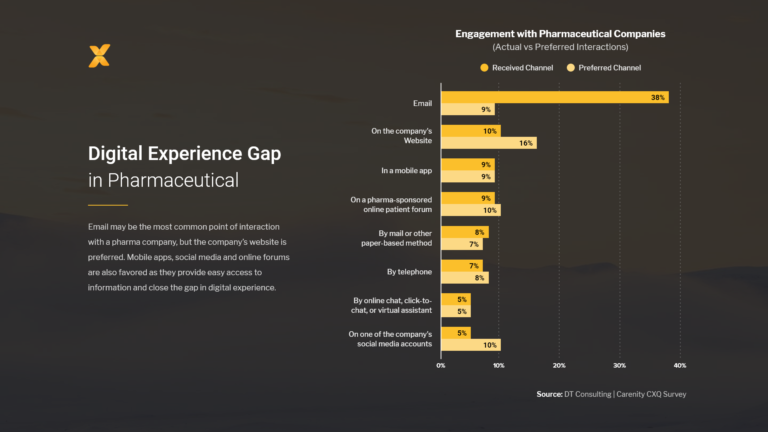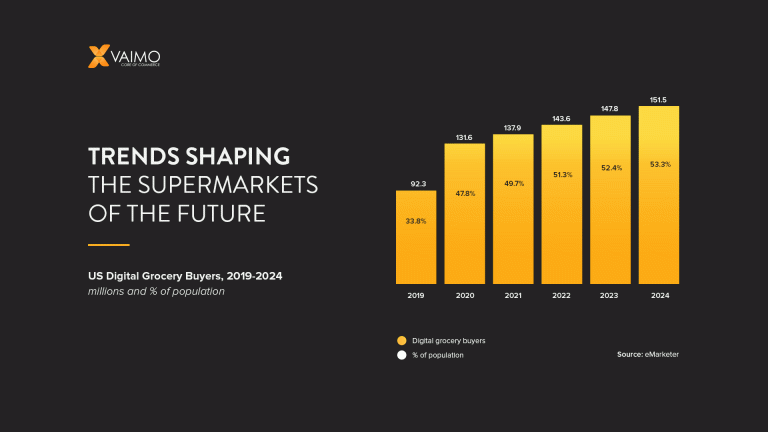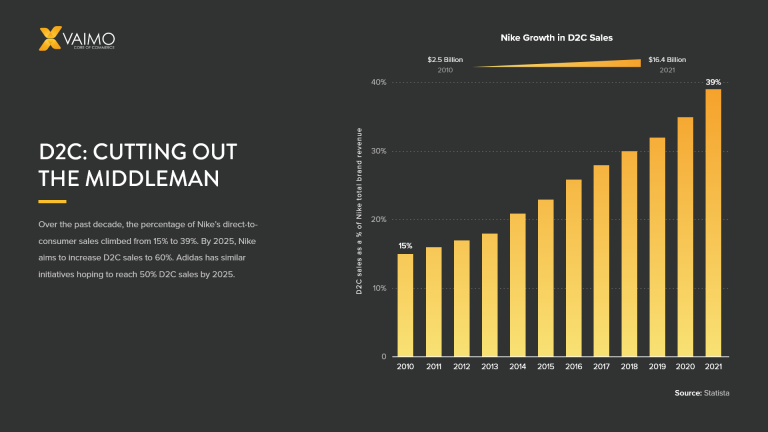D2C (direct-to-consumer) eCommerce is on the rise. Recent data suggests that while only 4% of millennials prefer D2C brands over traditional retailers, this grows to a whopping 40% to 45% for Gen Z-ers.
This shift and the digital transformation of shopping habits are causing the D2C market to boom. In a post-pandemic world where consumer behaviors are trending toward online, and a record 12,200 retail stores closed in one year, brands that previously sold their products through traditional retail methods need to pay attention.
This guide will walk you through the basics, detailed business model, and the unique challenges and benefits of D2C selling. This guide will help you prepare your business to increase profits through an intelligent D2C eCommerce strategy.
D2C Basics
At its very basic level, D2C takes place when a manufacturer sells their product directly to a consumer without using a distributor or retailer.
D2C is a popular choice for brands that want to enter the market quickly and with a lower entry-level cost. With the rise of eCommerce, more and more businesses are seeing the opportunity to cut out the middleman and sell directly to their consumer.
In some cases, a brand is born solely as D2C, such as the Dollar Shave Club. In other situations, an existing brand enters the D2C market later in the game, increasing their market share, such as PepsiCo. Still, others are born as D2C and wind up selling products through retailers down the road, such as BarkBox.
Whether a business is utilizing a straight D2C business model or a hybrid, the core of D2C revolves around direct product access for consumers.
A Market Prime for D2C
Recent studies have shown that COVID-19 pushed eCommerce five years ahead of where it would have been and, subsequently, caused many brands to hasten their adoption of D2C models. In 2021, there are an estimated 230.5 million Americans who shop online.
With an increasing number of consumers turning to the internet to make purchases, the market is prime for D2C brands to enter.
A D2C strategy is an affordable and easy method to launch a new brand. Companies can begin as an online store and test their ability to sell a product line long before investing in the traditional retail supply chain.
What Are the Benefits of D2C?
Shifting from a distribution-only model to a D2C marketing strategy is a beneficial move for many businesses. As retail stores close and shoppers turn to the internet for their wares, selling products directly to consumers can allow your business to diversify, opening up an entirely new revenue stream. This revenue is no longer tied up with the rise and fall of retailers and distributors, and is, instead, a fate controlled solely by you and the effectiveness of your marketing strategy.
Embrace an Omnichannel Experience
While the omnichannel experience has been around for much longer than the past year, 2020 accelerated the need for this experience.
With stores forced to close their doors, businesses had to invest in digital channels or get left behind. The result is that customers now expect that they can contact brands and order products through multiple channels.
D2C is simply a part of the holistic omnichannel experience.
For example, perhaps pre-pandemic, Matt was accustomed to heading to the grocery store to stock up on snacks each weekend. With COVID-19 surging, Matt decides to cut down on any in-store interactions. Seeing that PepsiCo now offers an online Pantry Shop, Matt decides to simply purchase his snacks directly from PepsiCo, keeping his cabinets stocked without ever leaving home.
While the opportunity to return to in-store shopping is back on the rise, Matt has found it more convenient to simply order a pre-planned pantry box directly from PepsiCo, allowing him to interact with the brand from whichever channel he prefers.
Know Your Customer Better
One of the number one benefits of switching to a D2C eCommerce strategy is that it allows you to get to know your customer better. In traditional retail models, you are always at least one step removed from your consumer.
By implementing a D2C strategy, you can start to gather data on your consumers, learning more about who they are and what they prefer. This can not only fuel your current marketing efforts but can also allow you to think strategically about future product releases.
Additionally, D2C sales let you manage your customer data in the best way possible. With the increasing concern around privacy and security, having a solid handle on your customer data is key to building long-term brand trust.
Go to Market Faster
Traditionally, launching a product meant finding a distributor and retailer who were willing to give up shelf space for your product. This made the process of going to market cumbersome and fraught with roadblocks.
D2C eliminates your dependency on others to get your product to market. Many established brands even use D2C to take experimental products to market without risking their retail partnerships. Rather than asking for shelf space for a trial run, D2C allows these brands to test out a limited product for long-term viability.
More Control Over Your Brand and Products
When you hand over your product to another business to sell, you give up a lot of control around your brand image. Where will the retailer place your product? Will they uphold your brand standards? What will sales staff say about your brand?
When you launch a D2C eCommerce strategy, you take back control over product presentation, branding, and communication around your brand to customers.
This also allows you to provide outstanding customer service that solidifies brand loyalty amongst consumers.
Expand Your Territory
Retail centers and distribution networks often limit territory expansion. These constraints make it difficult to take market share from competitors and drive growth.
By implementing this approach, you can transcend the traditional constraints of retail-dependent business models.
Customers can be located across the country or even across the globe. Backed by the right fulfillment and delivery strategy, you can expand your territory overnight.
Reduce Costs & Dependencies
By April 2020, unemployment rates hit historic highs with over 23 million in the US without work. The result is that consumers were forced to tighten budgets, and businesses had to find ways to reduce costs.
D2C is one such method that can help lower costs by increasing self-service and automation. While retailers have traditionally relied on in-person sales, eCommerce has opened the floodgate for consumer automation.
For example, when PepsiCo sells a box of chips to Matt via their online PantryShop, they are spending far less on labor and supply chain costs. With a few clicks of a button, Matt can purchase his box of chips and track the shipping straight to his front door with little to no human interaction.
Customer service, while still relevant, is handled by fewer agents via a streamlined combination of AI chatbots and real humans.
Not only does D2C allow brands to reduce costs, but it also removes dependencies. Reliance on distributors and retail partners always puts companies at risk. The fewer dependencies your brand has on outside vendors, the more predictable your business outcomes.
What are the challenges of D2C?
D2C offers an array of benefits for many brands. However, transition to a D2C strategy also comes with risks. This is particularly true for brands looking to implement a hybrid approach to D2C and traditional retail models.
Competing with Retailers and Distributors
When a brand, such as PepsiCo, adds a D2C option for their products, they are, in a sense, competing with retailers and distributors.
This can create complexities in relationships with long-term partners. Not all retailers will be thrilled to find out that your brand is setting up its own virtual shop.
Navigating this requires diplomacy and strategy. For example, some brands choose to only launch limited edition or pilot products via D2C channels to protect relationships with retailers. This ensures that there is no direct competition between a brand and its distributor.
Regardless of the approach, brands have to think about the impact their foray into D2C will have on existing relationships.
Fulfilling Orders
For many brands that have relied on a traditional distribution and retail model, switching to D2C will make it difficult to ensure smooth fulfillment of orders.
Consumers today have high expectations for order fulfillment. In fact, according to a study by OSM worldwide, 55% of online shoppers expect order status updates to be current as of a few hours ago or even more timely, with 40% of online shoppers citing that they check an item’s order status at least once per day.
This makes it imperative that companies considering a D2C eCommerce strategy are ready to handle the fulfillment process to prevent damage to their brand’s image.
Where should you start?
While entering the D2C market does come with a set of risks and challenges, brands that do it well will set themselves up to be successful in the years to come. With younger generations flocking to D2C brands, companies need to start building the framework for a D2C strategy now.
Customer Experience
Every company is a customer service company, and this customer experience is crucial when going D2C.
Warren Buffett said it well: “It takes 20 years to build a reputation and five minutes to ruin it. “
Before putting your products on the market to sell directly to consumers, think through the customer experience. Take the time to analyze your customer journey and use objective data points to determine where you need improvement.
Sales
For brands that offer both D2C and retail experiences, your team should start by identifying gaps between channels. The goal is to ensure that the experience you are offering is cohesive both online and offline.
In addition, you need to foster a culture that embraces D2C selling. Without sales and marketing teams on board, a D2C strategy cannot flourish.
This might mean creating incentives for your in-store team to help conduct D2C sales if the local store doesn’t have the desired product in stock or adding new KPIs for your marketing team to hit around D2C sales.
Technology
One of the most easily overlooked and yet critical components of a D2C strategy is a quality, scalable eCommerce platform. The right technology is necessary to ensure that your D2C plan succeeds in the long term.
Take the time necessary to vet technology solutions and only settle on a solution that will empower all teams to work collaboratively and efficiently.
Marketing
The beauty of D2C is that it allows you to broaden your horizons and tap into a whole new market share. However, for your marketing strategy around D2C sales to succeed, you must focus on performance.
Assess conversion rate optimization constantly and look for ways to improve the customer journey over time. This can involve A/B testing, data analysis, and outside-of-the-box marketing ideas.
D2C Trends to Keep Your Eye On
As more and more people turn to online shopping to fulfill their daily wants and needs, it is important to keep your eye on the trends.
Personalized Experiences
A big part of D2C’s appeal is that a consumer can interact directly with your brand.
This interaction often contains an emotional component.
For this reason, personalized experiences are promising to play a bigger role in keeping customers loyal in the years to come. Not only that, but a personalized experience further emphasizes the convenience provided through a D2C site.
International Expansion
D2C allows brands to expand to international markets rapidly.
Using a scalable eCommerce solution, such as Magento Commerce, you can easily offer your products to new customers across the globe in different currencies and languages. Be sure that, when choosing a technology solution, you are focusing on the potential to one day expand internationally.
Seamless Expectations
Customers are comfortable interacting with businesses across multiple channels, from the initial research stages to their final purchase.
However, too often, customers feel like their communication with businesses is not seamless. When being passed from one department to the next, it can come across to customers that a brand is not equipped to keep up with their customer journey.
Get Started Today
Is D2C on your list of things to prioritize in the years to come? Vaimo is here to help. We can work with your team to build a robust strategy around D2C eCommerce. From assessing your current customer experience to ensuring you have the right technology in place to deliver, our team will provide you with the expertise needed to succeed in this new market.
What are you waiting for? Get your D2C strategy launched today.







